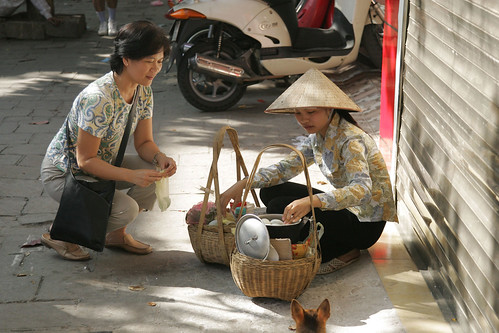Lucy Lapar, an ILRI scientist, with a trader selling eggs in Hanoi, Vietnam. A CGIAR Research Program on Livestock and Fish is working to help poor communities play a bigger role in feeding the growing populations in developing countries (photo credit: ILRI/Stevie Mann).
Last week (20–22 May 2013), a group of the word’s leading pro-poor livestock and other agricultural researchers met in Ethiopia to review ways of helping poor communities play a bigger role in feeding their developing countries’ growing populations by increasing their production of livestock-based foods—and doing so in ways that are sustainable over the long term.
Four CGIAR research institutions—the International Center for Agricultural Research in the Dry Areas (ICARDA), the International Center for Tropical Agriculture (CIAT), the International Livestock Research Institute (ILRI) and WorldFish—as well as many other partners are working together in the CGIAR Research Program on Livestock and Fish.
Tom Randolph, an agricultural economist at ILRI who directs this multi-disciplinary, multi-institutional research program, opened the Addis Ababa meeting by reviewing the objectives, challenges and achievements of the program over its first one and a half years.
What we signed up to do
This program can directly help the world’s poor small-scale food producers and sellers significantly contribute to, and benefit from, meeting the challenge of feeding 9 billion people by 2050. This program focuses on the critical role animal-source foods play in nutritionally challenged populations. And it works to find ways to better organize, target and sustain the ‘intensification agenda’ for developing-world animal agriculture.
Changing the way we do business
We’re moving away from developing solutions to discrete livestock development problems faced by livestock keepers in specific settings to addressing all the bottlenecks in whole ‘value chains’ for pork, dairy and small ruminant production in eight selected developing countries. We’re working with partners to design integrated livestock development interventions that will work at large scale. And we’re working directly with development partners to better understand local context and to test our research-based interventions.
What we’ve achieved so far
Technology and research outputs, from both CGIAR ‘legacy’ projects and new ones, have led to improved fish strains, fodder varieties and smallholder dairy livelihoods.
Challenges we’ve faced
Developing a shared vision and coordinating plans among the many institutions involved in the program’s many projects, as well as filling several human resource gaps at program and project levels, have been real, if anticipated, challenges for this new program.
How do we work better
Our objective is to design smart interventions that work at large scale. To succeed, we’ll need to invent new research methods and frameworks. And we’ll need to strengthen our partnerships with other research groups and work more effectively with development actors on the ground.
Seize the opportunity
This program expands our opportunities to do what many of us have always wanted to do—to ‘dig in’ to longer term research conducted in more meaningful partnerships.
View the full slide presentation by Tom Randolph:

